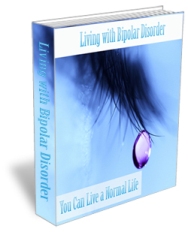|
Bipolar Disorder Guide
Bipolar Disorder Articles
Home
A Bipolar Disorder Checklist to Identify the Symptoms
A Bipolar Disorder Diagnosis is Difficult to Make
A Bipolar Quiz Helps Diagnose if the Disorder is Present
A Bipolar Test Will Identify the Severity of the Disorder
Bipolar Disease Has Many Extreme Levels
Bipolar Disorder in Children Can Present Different Than in Adults
Bipolar Medications Must be Carefully Monitored
Bipolar Symptoms For the Awareness of the Bipolar Disorder
Bipolar Treatment Through Medication and Counseling
Dealing with Bipolar Disorder Takes Time and Patience
The Behaviors of Bipolar Disorder are Disruptive to Everyone
The Chemistry of Bipolar Disorder is an Ongoing Study
The Family Suffers When a Mother Has Bipolar Disorder
The History of Bipolar Disorder Shows It Has Always Existed
The Relationship of Bipolar and Depression
The Types of Bipolar Support Programs That Can Help

CLICK
HERE
To Learn More
Related Links
HealthDuties
|
The Relationship of Bipolar and Depression
Bipolar disorder was earlier referred to as manic depressive
illness and the term clearly indicates a relation between bipolar and depression. It is a cyclic disorder
where the patient experiences mood swings that oscillate between abnormally elevated episodes to
depressive phases.
The depressive phase may last for a certain period of time and the major depressive phases are characterized by
feelings of extreme sadness, anxiety, hopelessness and isolation. Along with this, the patient may experience fatigue, loss of
sleep and appetite, declining interest in various activities etc. Sometimes the depressive phase leads to suicidal situations and
psychotic symptoms in the form of hallucination and delusion may be evident in the patient.
Bipolar and depression cannot be separated as the patient continuously fights between manic and depressive
phases. While the manic phase leads to increased irritability, unusual behavior, increased energy and unrealistic belief, the
depressive phase drowns them in feelings of helplessness, anxiety, persistent thoughts of death and a loss of
concentration.
Depression can be a very dangerous stage as the person experiencing such feelings cannot come to terms with the
things happening around him or her. Patients often feel that they cannot do anything and have lost all their energy. Such
feelings often trigger suicidal attempts. Family members and others taking care of people suffering from the disorder must always
monitor their activities. Anti-depressant drugs like Bupropion, Venlafaxine, Fluoxetine, Paroxetine can be prescribed for
patients suffering from the bipolar and depression.
Mood
stabilizers along with anti-depressants are often effective in providing relief. The
depressive phase of bipolar disorder varies significantly from person to person. While some people experience acute phases of
depression, others might experience manic episodes without any major depressive phase.
Bipolar and depression can be closely linked with each other. But, bipolar disorder can be divided into 4
types of mood disorders consisting of Bipolar I, Bipolar II, Cyclothymia and Bipolar Disorder NOS (Not Otherwise Specified), and
the depressive phases experienced by people largely depend on the kind of mood disorder they have. The disorder is considered a
serious illness since it cannot be cured and sufferings continue for life.
The depression associated with it can take serious dimensions when it continues for longer periods of time. The
person may completely lose interest in life and may not even come out of bed or have food or medicines that can provide relief.
Manic depression makes people suicidal and psychotherapy can be effective for people suffering from the disorder.
|